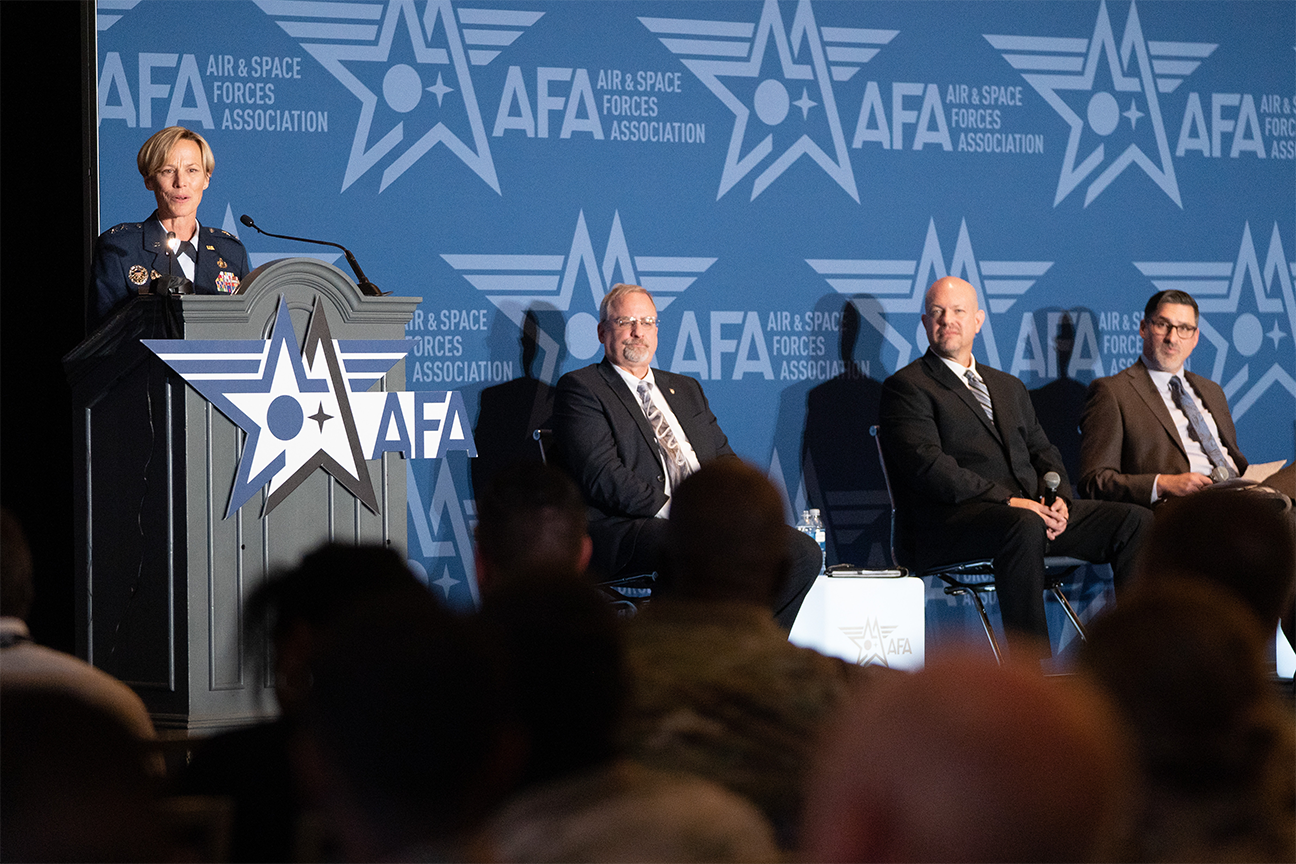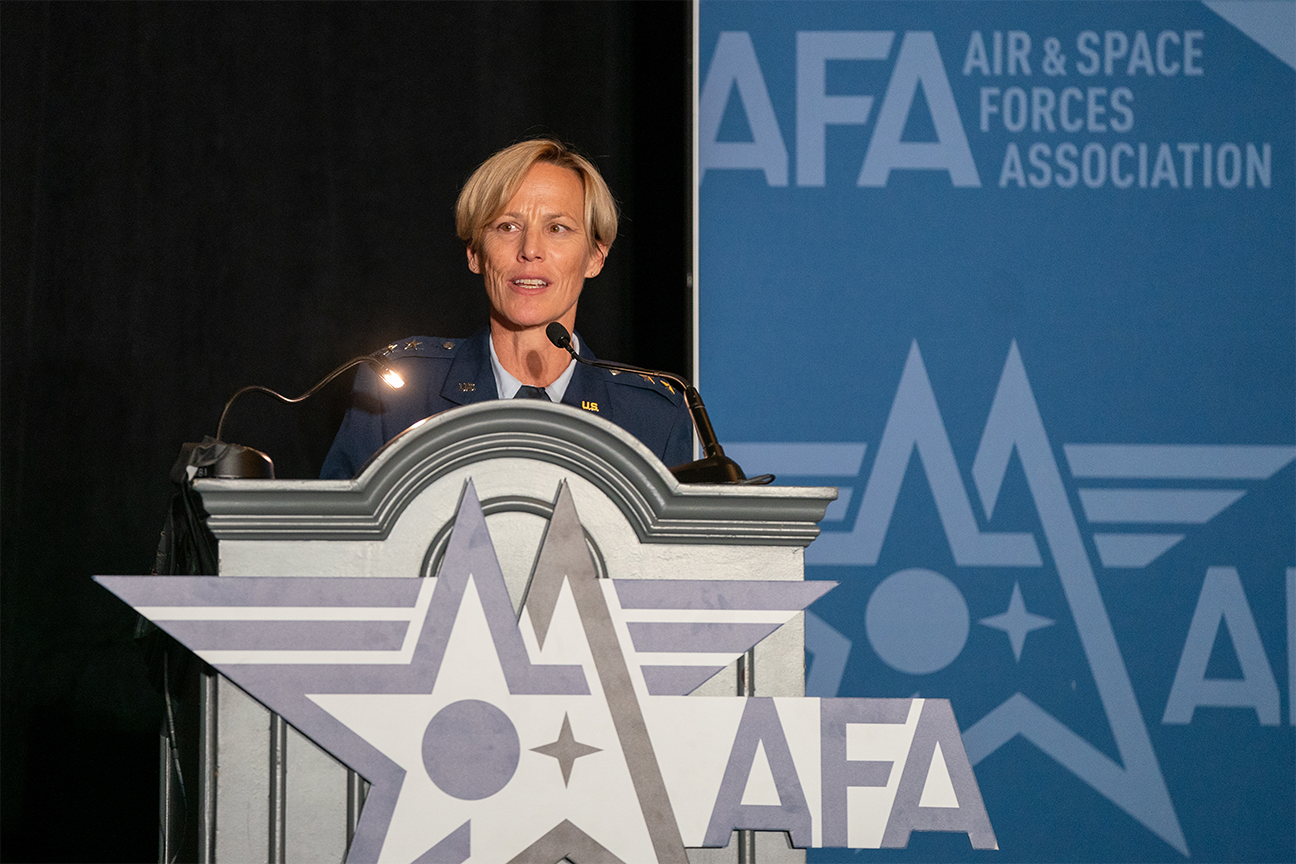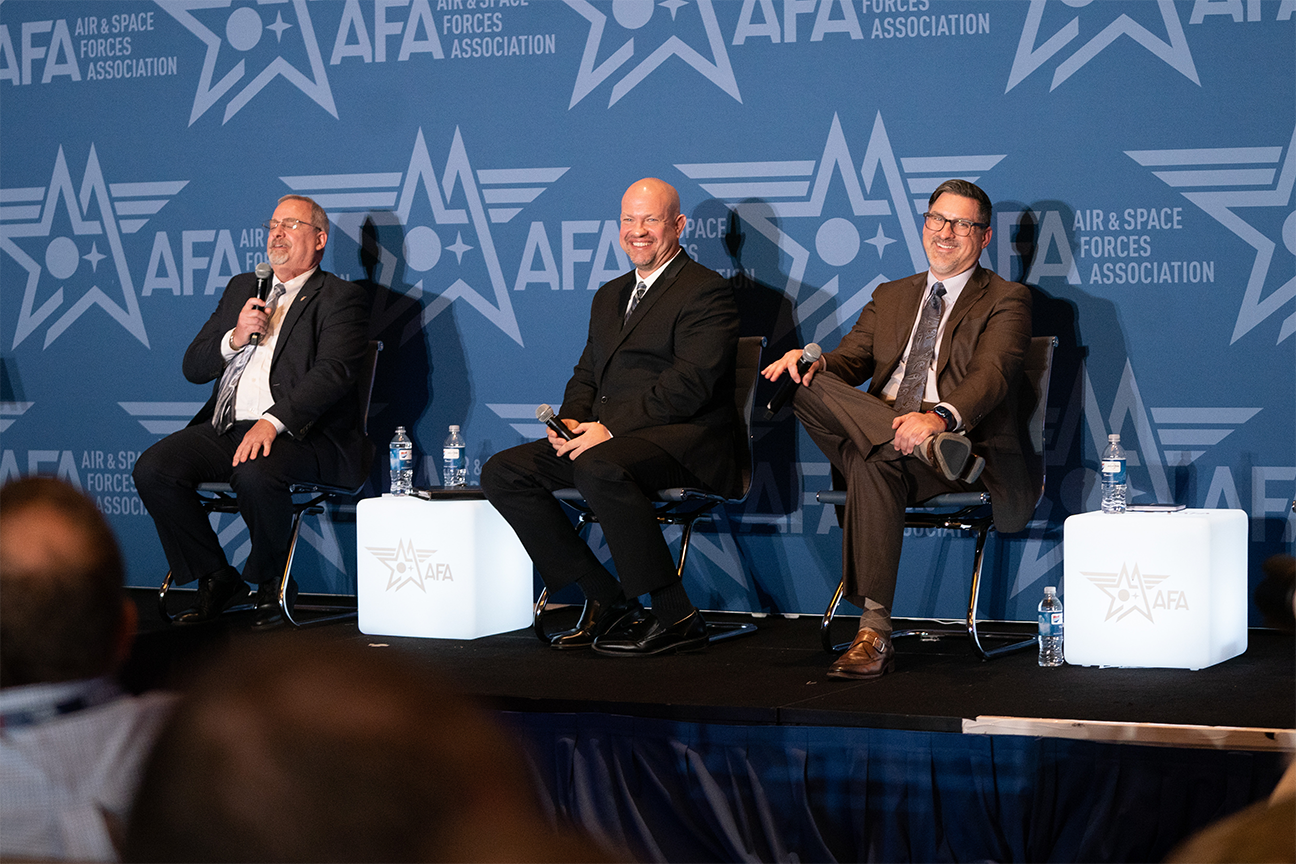NATIONAL HARBOR, Maryland – Maj. Gen. Heather Pringle, Air Force Research Laboratory commander, moderated a future of propulsion panel comprised of Air Force experts Sept. 21, 2022, during the Air and Space Force Association’s Air, Space and Cyber Conference at the Gaylord National Resort and Convention Center in National Harbor, Maryland.
“We’re really proud to be a part of telling you about the future of propulsion,” Pringle said. “It’s often an unsung technology, but it’s really helped us achieve the air power and space power that we see today. In the air domain, for example, propulsion is a critical component of our quest to attain faster speeds, greater range, higher altitudes and improved power and thermal management capabilities.”
Pringle was joined by the Director of AFRL’s Aerospace Systems Directorate, Dr. Michael Gregg; Chief of AFRL’s Rocket Propulsion Division, Dr. Shawn Phillips; and the Director of Air Force Life Cycle Management Center’s Propulsion Directorate, John Sneden.
Not only is propulsion critical to the air domain, Pringle said, but she also expressed its significance in space domain operations and “engines, rocket, propulsion – they’re really here to stay.”

From left: Air Force Research Laboratory Commander Maj. Gen. Heather Pringle moderates a future of propulsion panel with Director of AFRL’s Aerospace Systems Directorate, Dr. Michael Gregg; Chief of AFRL’s Rocket Propulsion Division, Dr. Shawn Phillips; and the Director of Air Force Life Cycle Management Center’s Propulsion Directorate, John Sneden, Sept. 21, 2022, during the Air and Space Force Association’s, Air, Space and Cyber Conference at the Gaylord National Resort and Convention Center in National Harbor, Maryland. (U.S. Air Force photo / Cherie Cullen)
NEW AFRL WORK
When it comes to leading the future of research and development in propulsion, Pringle asked Gregg about major AFRL developments.
“When I talk about propulsion, it’s across the whole spectrum,” said Gregg, director of AFRL’s Aerospace Systems Directorate. “It’s not just the fighter jet engines. It’s rocket engines, solid rocket motors.”
Gregg explained that AFRL is covering what it means to propel objects in air and space on a large spectrum, including how to use green fuels in space, all while making the right investments. Additionally, AFRL is focused on investments in dynamic innovations that are more efficient and optimal for the space domain, with the biggest being multi-mode propulsion.
While working with industry partners, Gregg added the laboratory has “great partnerships across the spectrum of looking at this really interesting technology space.”
ALIGNMENT
AFRL’s Rocket Propulsion Division also aligns propulsion investments with commercial space.
“How have you adjusted propulsion investments to align with what they’re doing in the commercial industry, which is really seeing an uptick in activity and it’s really pointing us to some new and exciting directions?” Pringle asked Phillips, who oversees all research, development and testing at AFRL’s Rocket Propulsion Division.
“Every large liquid rocket engine ever developed or tested in the United States has its footprint in AFRL,” Phillips said.
However, the goal is to move away from the large, lengthy liquid rocket engine programs, Phillips added.
“We look and say, ‘how do we actually get this responsive market happening at the S&T [science and technology] front, and bring these companies that turn their eyes toward the DOD?’ And we did that with Rocket Cargo,” Phillips said.
He continued discussing ways to change the portfolio from large engines to space capabilities by looking at contracts for mobility and adaptive systems that will allow the U.S. Space Force to operate in space.
“But as we know … Space Operations is a different machine,” he added. “Now, it’s … [about how the] operation aperture is open to the point of what we [can] do and what do we need to do. [And] that multimodal propulsion is — we have to enable an architect out there that can be still in that space, but maneuver without regret — give you the tools, propulsion capability that allows you to go where you need to go.”

Air Force Research Laboratory Commander Maj. Gen. Heather Pringle moderates a future of propulsion panel Sept. 21, 2022, during the Air and Space Force Association’s, Air, Space and Cyber Conference at the Gaylord National Resort and Convention Center in National Harbor, Maryland. The panel included Director of AFRL’s Aerospace Systems Directorate, Dr. Michael Gregg; Chief of AFRL’s Rocket Propulsion Division, Dr. Shawn Phillips; and the Director of Air Force Life Cycle Management Center’s Propulsion Directorate, John Sneden. (U.S. Air Force photo / Cherie Cullen)
CONTINUED INVESTMENT
Meeting the warfighters’ needs is an operational imperative, now and in the future, and Pringle looked to Sneden, director of Air Force Life Cycle Management Center’s Propulsion Directorate, to answer why AFRL continues to invest in propulsion and what more is needed.
He said investing in propulsion ensures warfighters have the next generation of equipment and systems, which drives readiness and capability.
“There [are] multiple factors that go into why you should invest but at the end of the day, they all support the SECAF’s operational imperatives,” Sneden said.
He gave two reasons to invest: drive capability for the warfighter and to stay ahead of China.
“And China has a very specific focus of catching up to the U.S., get into propulsion parity and exceed our capabilities,” he added. “We have to be able to transition our next generation technology. We have to be able to update the performance capability of our legacy systems and ensure the warfighter has the readiness and the capability to be able to fly, fight and win.”
Additional reasons to invest, Sneden added, include giving industry a place to practice digital transformation, maintain a viable industrial base, as well as sustain programs that drive safety, reliability and maintainability.
Sneden said the U.S. has long enjoyed having propulsion dominance and currently has the propulsion advantage over China.
“I don’t want anybody walking out of here thinking anything other than the U.S. has the world’s most capable, reliable [and] safe propulsion fleet in the world,” he said.
However, he added that it is imperative to “keep an eye on our adversaries,” and AFRL must continue to “always be innovating, always be moving forward.”
And while Sneden said China’s catching up, the U.S. has “no intention of actually letting China catch up with us.”
CHALLENGES IN CHANGE
Pringle asked Phillips, chief of AFRL’s Rocket Propulsion Division, to discuss his transition from large liquid rocket engine development to responsive launch systems.
Phillips said the challenge lies in bringing “the entire commercial space market both in the space access and in space — how [do] we turn it back toward us … and what are their needs?”
It came to two things, he said, resources and culture change.
Regarding resources, Phillips said public/private partnerships are imperative and are a collaboration. He recounted the number of companies that completed “things for pennies on the dollar for launch services [and] space — companies are invested in our multimodal propulsion for the nation.”
Not only did Phillips ask how to get companies to look at AFRL again, but he also asked how to get the multi-billion-dollar new space enterprise to turn their eyes toward government needs. With programs such as Aerospike Rocket Integration and Suborbital Experiment, or ARISE, and now the Tactically Responsive Space Access, or TRSA, AFRL has seen a quicker pace.
MAINTAINING ADVANTAGE
Pringle asked Gregg, director of AFRL’s Aerospace Systems Directorate, about AFRL’s ability to maintain the advantage of propulsion.
“We’ve been working with industry,” Gregg said. “We’ve been using true digital engineering to design a new manufacturing way of doing business. With a digital way of doing the propellant and new ways of doing the solid rocket motor cases.”
With the power of digital transformation, Gregg said it is an exciting time to be in space with its ability to rapidly manufacture. Additionally, he said rotating detonation engines represent an important advancement.
“[By achieving] anywhere from five to 25% improvements in fuel efficiency, and fewer moving parts in the combustion chamber of that, which means you have a smaller form factor, or if you want to keep the same form factor, you can double your range,” Gregg said. “This is a significant leap ahead, especially where we want to go with things like long range strike.”
With improvements to the digital environment, the lab has gone from a lot of very expensive materials to using “digital modeling to help us focus,” he said. These changes shorten the time and shrink costs, “and we can drive in on exactly what we need to do that much faster.”

From left: Director of AFRL’s Aerospace Systems Directorate, Dr. Michael Gregg; Chief of AFRL’s Rocket Propulsion Division, Dr. Shawn Phillips; and the Director of Air Force Life Cycle Management Center’s Propulsion Directorate, John Sneden, discuss the future of propulsion Sept. 21, 2022, during the Air and Space Force Association’s, Air, Space and Cyber Conference at the Gaylord National Resort and Convention Center in National Harbor, Maryland. (U.S. Air Force photo / Cherie Cullen)
LOGISTICS
And when it comes to digital transformation and the propulsion system, Pringle asked Sneden, director of Air Force Life Cycle Management Center’s Propulsion Directorate, to discuss how AFRL can drive an agile and responsive industrial base capability to the warfighter.
“Our intent is to drive improved readiness, responsiveness, safety, and competitiveness through digital transformation, and we have a lot of work to do … it’s an operational imperative,” Sneden said.
Because it currently takes 10-15 years to develop a new engine system and a few years’ lead time to secure legacy components, Sneden said he continues to discuss ways to improve responsiveness in development and sustainment.
And with existing component lead times and the rising costs from worldwide inflation, Sneden said the supply chain is not very responsive, so other initiatives are necessary to keep costs down and improve speed.
On the development side, “We are designing and validating our next generation adaptive propulsion system in a digital environment,” Sneden said. “And that’s a huge transformation.”
Furthermore, under the umbrella of sustainment, there are many programs driving transformation.
“We have adopted an advanced manufacturing and repair ecosystem that’s yielded the first airworthiness approved additively manufactured component flying in multiple systems today,” Sneden said, as an example.
With many activities focused on moving the enterprise further into the future faster, Sneden said, “the team is leaning fully into this. They have embraced the digital transformation.”
ABOUT AFRL
The Air Force Research Laboratory (AFRL) is the primary scientific research and development center for the Department of the Air Force. AFRL plays an integral role in leading the discovery, development and integration of affordable warfighting technologies for our air, space and cyberspace force. With a workforce of more than 11,500 across nine technology areas and 40 other operations across the globe, AFRL provides a diverse portfolio of science and technology ranging from fundamental to advanced research and technology development. For more information, visit: www.afresearchlab.com.

